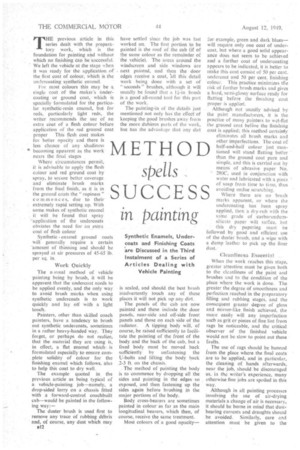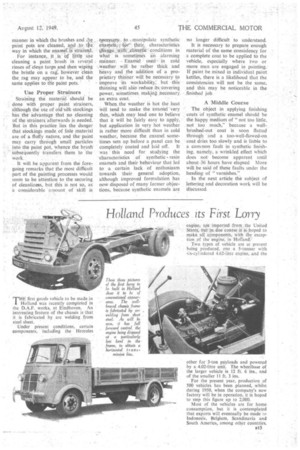METHOD
Page 46

Page 49

If you've noticed an error in this article please click here to report it so we can fix it.
spells
SUCCESS
in painting
Synthetic Enamels, Undercoats and Finishing Coats 'are Discussed in the Third Instalment of a Series of Articles Dealing with Vehicle Painting
THE previous article in this series dealt with the preparatory work, which is the foundation for painting and without which no finishing can be successful. We left the vehicle at the stage ',ellen it was ready for the application, of the first coat of colour, which is the rin:lercoating synthetic enamel.
For most colours this may be a, single coat of the maker's Undercoating or ground coat, ' which is specially formulated for the particular synthetic-resin enamel, but for reds, particularly light reds, the writer recommends the use of an extra coat of a flesh colour heave application of the red ground coat proper This flesh coat makes for better opacity and there is • less chance of any shadiness • becoming apparent as the work nears the final stages .
Where circumstances permit, it is advisable to apply the flesh colour and red ground coat by spray, to secure better coverage and eliminate brush marks from the final finish, as it is in the ground coats the " ropiness" commences, due to their extremely rapid setting up. With some makes of synthetic enamel it will he found that spray `application of the undercoats obviates the need foe an extra coat of flesh colour Synthetic enamel ground coats will generally require a certain 'amount of thinning and should be sprayed at air pressures of 45-65 lb. per sq. in.
Work Quickly The n•zrmal method of vehicle painting being by brush, it will be apparent that the undercoat needs to be applied evenly, and the only way to avoid brush marks when using synthetic undercoats is to work quickly and lay off with a light touch.
• Painters, other than skilled coach painters, have a tendency to brush out synthetic undercoats, sometimes in a rather heavy-handed way. They forget, or perhaps do not realize, that the material they are using is, in effect, a 'flat enamel which, is formulated especially to ensure complete solidity of colour for the finishing enamel which follows, also to help this coat to dry well.
The example quoted in the previous article as being typical of a• vehicle-painting job—namely, a drop-sided lorry on a chassis fitted with a forward-control coachbuilt cab—would be painted in the follow
ing way:—
The duster brush is used first to remove any trace of rubbing debris and, of course, any dust which may B12 have settled since the job was last Worked on. The first portion to be painted is the roof of the cab (if of the same colour as the remainder of the vehicle). The areas around the windscreen and side windows are next painted, and then the door edges receive a coat, 'all this detail work being done with a set of " seconds" brushes, although it will usually be found that a 1;r-in. brush is a good all-round tool for this part of the work.
The painting-in of the details just mentioned not only has the effect of keeping the good brushes away from the more .dubious parts of the work, but has the advantage that any dirt
is sealed, and should the best brush inadvertently touch any of these places it will not pick up any dirt.
The panels of the cab are now painted and these include the door panels, near-side and off-side front panels and those on each side of the radiator. A tipping body will, of course, be raised sufficiently to facilitate the painting of the front of the body and the back of the cab, but a fixed body must be moved back sufficiently by unfastening the U-bolts and lifting the body back ,2-3 ft. on the chassis.
. The method of painting the body is to commence by dropping all the sides and painting in the edgesso exposed, and then fastening up the sides again before brushing in the major portions of the body.
Body cross-bearers are sometimes painted in colour as far as the main longitudinal bearers, which then, of course, receive the same treatment.
Most colours of a good opacity
for _example, green and dark blues— will require only one coat of undercoat, but where a good solid appearance does not seem to be achieved and a further coat of undercoating appears to be indicated, it is better to make this coat consist of 50 per cent. undercoat and 50 per cent, finishing colour. This practice minimizes the risk of further brush marks and gives a hard, semi-glossy surface ready for flatting before the finishing coat proper is applied.
Although not usually advised by the paint manufacturers, it is the practice of many painters to wet-flat the ground coat befOre the finishing coat is applied; this method certainly eliminates all brush marks and other imperfections. The coat of half-and-half colour just mentioned will stand flatting better than the ground coat pure and simple, and this is carried out by means of abrasive paper No, 280C, used in conjunction with water and lubricated with a piece of soap from time to time, thus avoiding undue scratching.
Where there are no brush marks apparent, or where the undercoating has been splay applied, then a dry-rub with the saine grade of carbortinclumsilicate paper will suffice, but • this dry papering must be followed by good and efficient use of the duster brush-, and a wipe with a damp leather to pick up the finer dust.'
Cleanliness Essential ._ When the work reaches this stage, greater attention must be given both to the cleanliness of the paint and brushes and to the condition of the place where the work is done. The greater the degree of smoothness and perfection reached in the preparatory filling and rubbing stages, and the consequent greater degree of gloss and mirror-like finish achieved, the more easily will any imperfection such as grit or pieces of fine lint from rags be noticeable, and the critical observer of the finished vehicle would not be slow to point out these faults.
The use of rags should be banned from the place where the final coats are to be applied, and in particular, the cleaning of hands afterwards, near the job, should be discouraged as. in the :writer's experience, many otherwise fine jobs are spoiled in this way.
Although in all painting processes involving the use of air-drying materials a change of air is necessary, it should be borne in mind that dustbearing currents and draughts should be avoided. Similarly, care and attention must be given to the
manner in which the brushes and :he paint pots are cleaned, and ..to• way in which the enamelis strainedir. For instance„ it , is Of littin. use cleaning a paint brush in several . rinses of Clean turps and then wiping the bristle on a raj, IfoWeVer Clean the rag may appear to be, and the smile applies to .the paint pots,
Use Proper Strainers straining the material should be .. done with proper paint strainers, althaigh,the irSe of old'silk stockings has: the advantage that no cleaning :Of the strainerS'afterwards is needed. But in this practice lies the danger that stockings made, of lisle material are of a fluffy nature,' and the' paint may carry through small particles into the paint 'poi, whence the brush . subsequently transfers them to the Work.
.. It will bp apparent from the fore7 going remarks that the most difficult part of the painting processes would seem to be attention to the securing of cleanliness, brit this is not So, as it considerable 'amount of skill is ripeqsa-tty.,,to manipulate synthetic crianelS;•z-fOr'' their, characteristics schange Withclmiatc' conditions i n what is sometimes an alarming manner. . Enamel ,usedin cold .weather . will be rather thick and heavy and the addition of a proprietary thinner will be necessary tO improve its workability; but -this thinning will aVo reduce its covering power, sometimes malOg necessary. an extra coat.
When the weather is hot the heat -will tend to make the enaniel` very thin, which may lead one to believe that it will be fairly easy to apply, but application in very hot weather is rather more difficult than in cold weather, because the enamel sometimes sets up before a panel can be completely coated and laid off. it was this need for studying the characteristics of synthetic resin enamels and their behaviour that led to a certain lack of enthusiasm towards their, general adoption, although improved formulation has now disposed of many former objecfirms, because synthetic enamels are
no longer difficult to understand.
It is necessary to prepare enough material of the same consistency for a complete coat to be applied to the vehicle, especially where two or more men are engaged in painting. if paint be mixed in individual paint kettles, there is a likelihood that the .consistencies will not be the same, and this may be noticeable in the .finished job.
A Middle Course The object in applying finishing coats of synthetic enamel should be the happy medium of "not too little, not too much," because a wellbrushed-out coat is soon flatted through 'and a too-well-flowed-on coat dries too slowly and is liable to a common fault in synthetic finishing, namely, a wrinkled effect which does not become apparent until about-36 hours have elapsed More will be said of these faults under the heading of varnishes," • In the next article the subject of lettering and decoration work will be discussed.




















































































